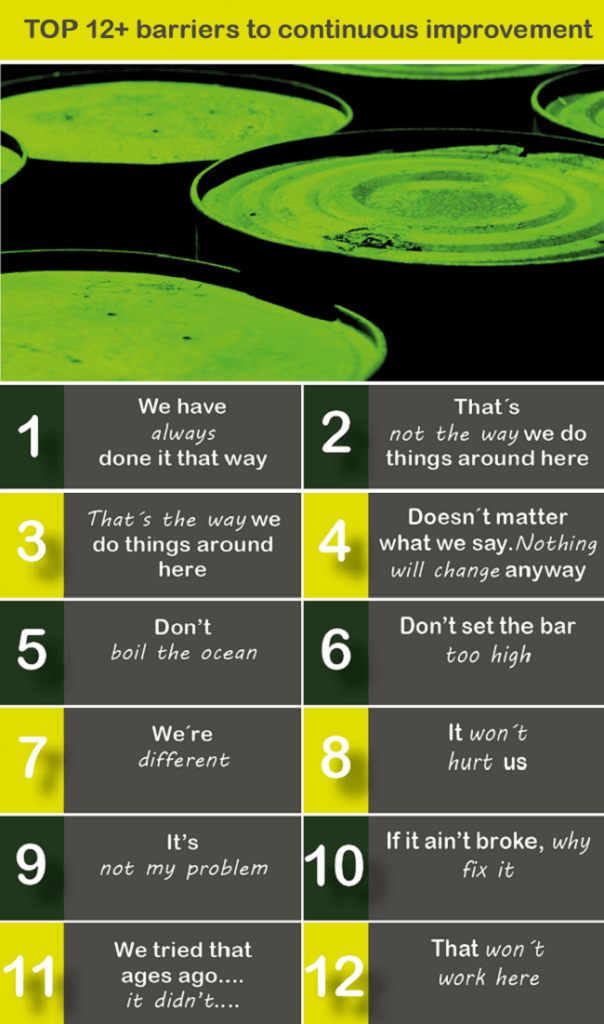Why do continuous improvement programs fail?
What do weight-loss plans and continuous improvement programs have in common? They typically start off well, generating excitement and great progress, but all too often fail to have a lasting impact as participants gradually lose motivation and fall back into old habits.
Continuous improvement is increasingly being touted as a competitive differentiator, but all too often companies are their own worst enemies. Just ask these “simple” question: Does the organizations culture support change? Will there be fear of the change?
Top 12+ barriers to continuous improvement programs
Don’t let these toxic phrases destroy continuous improvement program. Better deal proactively with them!

If fear of change is the root cause
If fear of change is the root cause of failures to create a culture of continuous improvement:
Drive out fear. No one can put in his best performance unless he feels secure
And if the program already is up and running:
Is the actual or “perceived” value of the change or improvement “believed, understood and accepted”?
What are your views about continuous improvement failure? What do you see as the root cause of failures to institute continuous improvement?
Short URL & Title:
Why do continuous improvement programs fail — http://www.torbenrick.eu/t/r/nri
Share it:
If you enjoyed this article, please take 5 seconds to share it on your social network. Thanks!








Rick, I couldn’t agree more with all bar one of these….
With no.5, I always say to people “we can’t boil the ocean, but we can put the kettle on!”
@Andy – “put the kettle on” reminds me of Clarke & Dawe on the oil spill: “…. we dropped a kind of shopping centre over the hole – underwater shopping centre” — http://www.torbenrick.eu/t/r/dzf (Parody as a tool in social media attack)
Most fail to sustain for the same reasons most fail to maintain a healthy diet and exercise routine- it’s hard work and requires great discipline. Therefore, it requires great leadership and daily involvement to ensure that gains are locked in through robust controls. A strong rapport with co-workers is required ( study NLP) & accountability to perform work as agreed is crucial.
Too many “leaders” spend their days dealing with endless emails and reports and end up doing little to nothing to ensure that a culture of true outperformance evolves and is sustained.
Rise up against the non value added work that saps our energy, time and Spirit!! It’s time for the Hamster Revolution!
Thanks Ron – Some very good points ?
Having viewed all types of CI programs since the 80s, many of the reasons cited here relating to leadership support, buy-in from the top, etc. are symptomatic of not appropriately involving leaders in program initiation, establishment of program goals, ongoing alignment with meeting business plan objectives, program governance & metrics, and CI project execution. Integrating CI into the fabric of how leaders do business means challenging the traditional leadership behavioral dynamics of how CI programs are planned, deployed and managed. These conditions noted above illustrate the challenge of business ownership:
— “Most of the time continuous improvement plan fails due to lack of support from top management and there is no long term commitment”
— I think the most likely culprit is a lack of full leadership buy-in and support
If you want to do a quick at-a-glance assessment to gauge business ownership, how do your programs rate in relation to:
1. Program Level: Is there a multi-year shaping plan that defines business objectives and program milestones; did the business own development of the shaping plan vs the CI gurus? HINT: If the business doesn’t own the shaping plan; they don’t own the CI Program!
2. Program Level: Who owns CI program performance metrics and drives metrics reviews; how are scorecard meetings conducted? What is leaderships role in assessing progress and actioning improvements?
3. Program Level: How does leadership celebrate/recognize and share CI Program results, accomplishments and Best Practices with ‘value chain’ stakeholders?
4. Project Level: How effectively are we engaging leadership from scoping/pre-define to deployment, such that leaders clearly know they own the full project and there is no perceived hand-off to leadership in the later stages? Have we pinpointed, in behavioral terms, leader roles of Sponsors, Champions, etc.?
“Mobility of management” will continually challenge the leadership ownership needed to reinforce the culture change (Culture: the patterns of behavior that get reinforced or punished by leaders/peers, and by systems, over time) required to weave CI into the fabric of how we do business. Nevertheless, what we can influence is changing CI Program governance and redefining leadership roles/responsibilities to reinforce that CI is a vehicle to obtain business objectives.
A accomplir we say, “just a little effective leadership goes a long way; nothing changes unless leader behaviors change”
Rick – all points right on spot. The underlying cultural assumptions (not expressed in words) within organization may be even more disturbing – “We are only improving with people from our culture! If you are not one of us, your insight, inquiry or advice will not me heard, and taken into account!”
Establishing a ‘Humble Inquiry” (see especially Edgar H. Schein’s book with same title) culture (from the very top down to the shopfloor – even though this might be long, and could bring up some tension within the management circles) will set a good ground to move into sustainable process improvement beyond the seen “low hanging fruit”.
Just my two cents!
The tone at the top e,g. complete commitment & support including requisite funding throughout the program is also important. Also, if the stakeholders “own” the program it will improve the chances of success. Inversely, absence of these factors could hamper success. Correctly estimating the cost, time frame and personnel involvement in the implementation also helps maintain the momentum., otherwise it may run out of steam.
Sustain fails because it’s the one that requires people to change their behaviour. Everything prior to that is a technicality. Too many organisations fail to manage behaviour to the degree necessary to reliably ensure compliance with the incremental elements of CI.
Vital presentations, when various changes done for continous imporvment than the direct line of improvment autumatically faced with various difficulties and problem that is why than facing with fail !
Fear to be open and honest in a highly competitive environment where judgement is based on a positive ‘lessons learnt’ outcome, without fear of recrimination will foster engagement at all levels. All too often, those individuals who can positively lead stand astride a seesaw, weighing the balance of compliance against financial performance. In the case of weight loss plans, people fear failure because of criticism or judgement which is personally driven. Support, support and more support to guide, encourage and celebrate what can be achieved will lift personal drive to want to succeed. Our latest generation of future leaders derive their perceptions via artificial social media, so how can they judge company culture? Well in the same way it is called ‘likes’ and ‘views’. Do we as the older generation not enjoy being patted on the back and enjoy recognition?